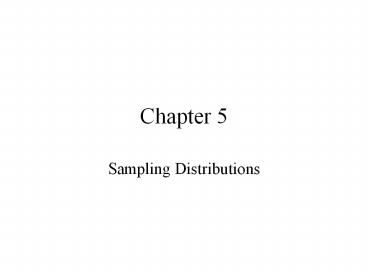Sampling Distributions PowerPoint PPT Presentation
Title: Sampling Distributions
1
Chapter 5
- Sampling Distributions
2
Introduction
- Distribution of a Sample Statistic The
probability distribution of a sample statistic
obtained from a random sample or a randomized
experiment - What values can a sample mean (or proportion)
take on and how likely are ranges of values? - Population Distribution Set of values for a
variable for a population of individuals.
Conceptually equivalent to probability
distribution in sense of selecting an individual
at random and observing their value of the
variable of interest
3
Sampling Distributions for Counts and Proportions
- Binary outcomes Each individual or realization
can be classified as a Success or Failure
(Presence/Absence of Characteristic of interest) - Random Variable X is the count of the number of
successes in n trials - Sample proportion Proportion of succeses in the
sample - Population proportion Proportion of successes in
the population
4
Binomial Distribution for Sample Counts
- Binomial Experiment
- Consists of n trials or observations
- Trials/observations are independent of one
another - Each trial/observation can end in one of two
possible outcomes often labelled Success and
Failure - The probability of success, p, is constant across
trials/observations - Random variable, X, is the number of successes
observed in the n trials/observations. - Binomial Distributions Family of distributions
for X, indexed by Success probability (p) and
number of trials/observations (n). Notation
XB(n,p)
5
Binomial Distributions and Sampling
- Problem when sampling from a finite sample the
sequence of probabilities of Success is altered
after observing earlier individuals. - When the population is much larger than the
sample (say at least 20 times as large), the
effect is minimal and we say X is approximately
binomial - Obtaining probabilities
Table C gives probabilities for various n and p.
Note that for p gt 0.5, use 1-p and you are
obtaining P(Xn-k)
6
Example - Diagnostic Test
- Test claims to have a sensitivity of 90 (Among
people with condition, probability of testing
positive is .90) - 10 people who are known to have condition are
identified, X is the number that correctly test
positive
- Compare with Table C, n10, p.10
- Table obtained in EXCEL with function
BINOMDIST(k,n,p,FALSE) - (TRUE option gives cumulative distribution
function P(X?k)
7
Binomial Mean Standard Deviation
- Let Si1 if the ith individual was a success, 0
otherwise - Then P(Si1) p and P(Si0) 1-p
- Then E(Si)mS 1(p) 0(1-p) p
- Note that X S1Sn and that trials are
independent - Then E(X)mX nmS np
- V(Si) E(Si2)-mS2 p-p2 p(1-p)
- Then V(X)sX2 np(1-p)
For the diagnostic test
8
Sample Proportions
- Counts of Successes (X) rarely reported due to
dependency on sample size (n) - More common is to report the sample proportion of
successes
9
Sampling Distributions for Counts Proportions
- For samples of size n, counts (and thus
proportions) can take on only n distinct possible
outcomes - As the sample size n gets large, so do the number
of possible values, and sampling distribution
begins to approximate a normal distribution.
Common Rule of thumb np ? 10 and n(1-p) ? 10 to
use normal approximation
10
Sampling Distribution for XB(n1000,p0.2)
11
Using Z-Table for Approximate Probabilities
- To find probabilities of certain ranges of counts
or proportions, can make use of fact that the
sample counts and proportions are approximately
normally distributed for large sample sizes. - Define range of interest
- Obtain mean of the sampling distribution
- Obtain standard deviation of sampling
distribution - Transform range of interest to range of Z-values
- Obtain (approximate) Probabilities from Z-table
12
Sampling Distribution of a Sample Mean
- Obtain a sample of n independent measurements of
a quantitative variable X1,,Xn from a
population with mean m and standard deviation s - Averages will be less variable than the
individual measurements - Sampling distributions of averages will become
more like a normal distribution as n increases
(regardless of the shape of the population of
individual measurements)
13
Central Limit Theorem
- When random samples of size n are selected from
aamy population with mean m and finite standard
deviation s, the sampling distribution of the
sample mean will be approximately distributed for
large n
Z-table can be used to approximate probabilities
of ranges of values for sample means, as well as
percentiles of their sampling distribution
14
Exponential Distribution
- Often used to model times survival of
components, to complete tasks, between customer
arrivals at a checkout line, etc. Density is
highly skewed
Sample means of size 10 (m1, s1/100.50.32)
Individual Measurements (m1,s1)
15
Miscellaneous Topics
- Normal Approximation for sample counts and
proportions is example of CLT (XS1Sn) - Any linear function of independent normal random
variables is normal (use rules on means and
variances to get parameters of distribution) - Generalizations of CLT apply to cases where
random variables are correlated (to an extent)
and have different distributions (within reason) - Variables made up of many small random influence
will tend to be approximately normal

